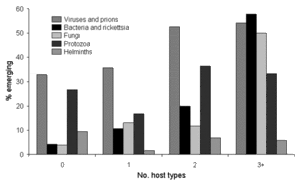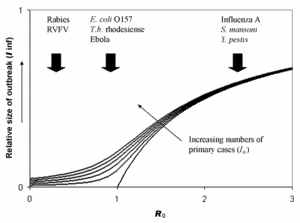Whole hog analysis of emerging diseases
 As I've mentioned a bunch of times now, I work with the Center for Emerging Infectious Diseases here at the U of Iowa. Our primary focus is zoonotic diseases (diseases which are transmitted between species), and being in an agricultural state, we have a special interest in pathogens of agriculture. A new analysis by Mark Woolhouse and Sonya Gowtage-Sequeria in the journal Emerging Infectious Diseases has taken a closer look at the origin of zoonotic diseases. By the numbers:
As I've mentioned a bunch of times now, I work with the Center for Emerging Infectious Diseases here at the U of Iowa. Our primary focus is zoonotic diseases (diseases which are transmitted between species), and being in an agricultural state, we have a special interest in pathogens of agriculture. A new analysis by Mark Woolhouse and Sonya Gowtage-Sequeria in the journal Emerging Infectious Diseases has taken a closer look at the origin of zoonotic diseases. By the numbers:- Of the 1407 human pathogen species, 816 (58%) are known to be zoonotic.
- Of the 177 emerging or reemerging pathogens, 130 (77%) are known to be zoonotic.
- Therefore, zoonotic pathogens are disproportionately likely to be associated with emerging and reemerging infectious diseases.
- Changes in land use/agricultural practices
- Changes in human demographics and society
- Poor population health
- Hospitals and medical procedures
- Pathogen evolution (e.g., antimicrobial resistance, increased virulence)
- Contamination of food or water supplies
- International travel
- Failure of public health programs
- International trade
- Climate change
Breaking it down by groups of organisms, this association (between emerging disease and zoonotic pathogens) is strongest for bacteria and fungi, less so for viruses and protozoa. (The other category, helminths--parasitic worms--are already almost all zoonotic anyway, and very few are considered emerging or reemerging). Ungulates (hoofed mammals--deer, horses, swine, etc.) were found to be the most important species overall, see figure below. So, thus far, we have 1) importance of agricultural practices, and 2) hoofed mammals (including many you'd find on a farm). I have a feeling this paper is going to be oft-cited in our future grant proposals.

They next grouped the pathogens according to host range, and found that greater than 40% of the pathogens with the broadest host range (3 or more types of nonhuman host) were emerging or reemerging:

Finally, they looked at transmissibility. Most zoonotic pathogens aren't easily transmitted between humans--humans are either a "dead-end" host, or minimal human-to-human transmission occurs. To look at this graphically, they plotted the R0 (the "basic reproductive number" for each pathogen; the number of secondary cases due to each case) on the X axis, and the relative size of each outbreak an organism caused on the Y:

So, the good news is that most zoonotic pathogens don't cause major epidemics. But, as they note in the discussion, we don't have a good way right now to predict whether a new pathogen will behave more like rabies (frequently introduced into the population, but doesn't cause major epidemics) or HIV (likely rarely introduced, but capable of causing a global pandemic). This is why we take things like H5N1 so seriously--especially because that's a virus family which, historically, is out in the upper right corner of that graph above. Right now H5N1 is in the opposite corner--introduced fairly frequently in the last year (~130 odd times thus far), but without significant transmission between humans. Hopefully it will stay that way, as many zoontic pathogens do. But as the authors also point out, good surveillance is, once again, the key--and to be thorough, we should go even beyond humans and ducks in an effort to better understand our microbial neighbors.


